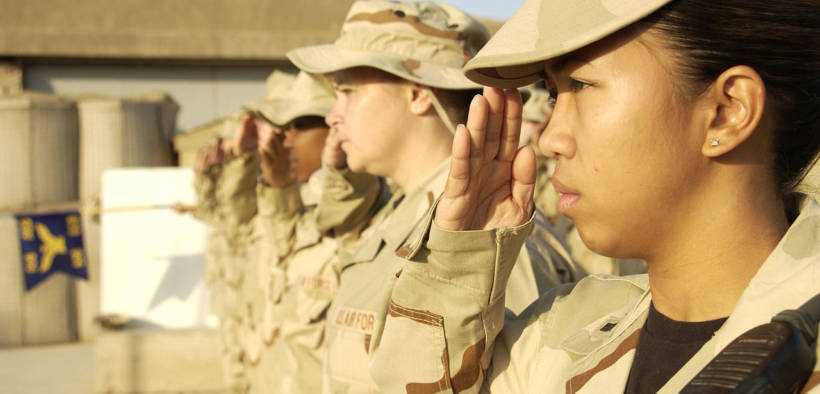Women in the U.S. May Have To Register for the Draft Soon

Women in the U.S. May Soon Be Eligible for the Draft
On March 24 a Congressional commission on military service issued a series of recommendations regarding the future of America’s Military, including a recommendation that women be required to register for selective service.
Women in the U.S. Military
Unlike women, men have been legally mandated to register for the draft since 1917, and until recently women were not even allowed to hold many jobs within the U.S. armed forces. The process of integrating the U.S. military has been slow. The Coast Guard opened all roles to women in 1978 and the Air Force removed gender barriers to certain positions in 1989. Up until 2016 women were prohibited on the basis of sex from holding certain roles within the Army, Navy, and Marines. Specifically, women were not allowed to become Navy SEALs, Army Rangers, or Green Berets. In 2015 Defense Secretary Ashton Carter removed remaining restrictions on military women’s service. Several women have now completed Army Ranger School, and in December of last year the first women completed Navy SEAL office selection and assessment.
Draft America’s Daughters Act
The 2015 policy change prompted some backlash and in 2016 Rep. Duncan Hunter (R-CA) and Rep. Ryan Zinke (R-MT) introduce the Draft America’s Daughters Act, which would have required women to register for the draft. Hunter is a former Marine and Zinke is a former Navy SEAL. The bill received some notable support, Senator John McCain (R-AZ) was Chairman of the Senate Armed Services Committee at the time and said “The fact is, every single leader in this country, both men and women, members of the military leadership, believe that it’s fair since we opened up all aspects of the military to women that they would also be registering for Selective Services.” Language from the Draft America’s Daughters Act was incorporated into the 2017 Defense Reauthorization Act and came close to passing before being revised to be call for ca congressional commission to make a recommendation rather than a mandate.
Court Case
In 2018, also prompted by the 2015 military policy change, a “men’s rights” group National Coalition for Men filed a lawsuit against the Selective Service System alleging that the male only draft was unconstitutional. The case was heard by the Southern District of Texas. The Judge decided in favor of the plaintiff and ruled that since all military jobs were open to women, male only draft registration was unconstitutional. The case was appealed and was set to be heard this month by the Fifth Circuit. Depending on how quickly the court case is heard and whether legislation is passed to include women in the draft there could be either a legislative change or a court ruled change to selective service later this year.
Other Countries’ Policies
Internationally the requirement for women to register for military service is a little unusual but not unique. According to Pew Research 23 countries have conscription laws but aren’t actually drafting anyone, the U.S. falls in this category. 60 other countries are actually conducing mandatory military service in some form. Of those 11 include women in the draft. Some of America’s allies that already conscript women include Israel, Sweden, and as of 2016 Norway.
Will the U.S. Ever Need the Draft Again?
The last time the U.S. drafted citizens into military service was during the Vietnam war. Mandatory military service in an controversial war was extremely unpopular and the requirement to register for selective service was suspended in 1975. President Carter reactivated selective service in 1979 and planned to require women to register for the draft then, but Congress did not pass the necessary funding to make the change. Since then all American men have been required to register for the draft within a few weeks of their 18th birthday, but the draft has not been activated. The U.S. maintains the most powerful military in the world exclusively with volunteers.
While it’s possible that a situation may arise sometime in the future that would require the U.S. to activate the draft it seems unlikely to happen any time soon given the current global military makeup. The U.S. military is the third largest in the world when it comes to active personnel, but understanding the true scope of U.S. military superiority means looking at the tools that modern wars are fought with, rather than just comparing numbers of people. For instance, the U.S. has 20 aircraft carriers, the rest of the world combined has 24. The U.S. Air Force is the largest air force in the world with about 5600 aircraft, the U.S. Navy and Marines combined have about 3700 aircraft and on their own would be the second largest air force on the planet, Russia is the third largest with just under 2000 aircraft. Overall annual U.S. military spending outpaces any other nation’s by hundreds of billions of dollars.
With those resources at their disposal it’s hard to imagine circumstances under which the U.S. Military would also need to forcibly conscript citizens. If, or more likely when, women are included in the draft it will most likely be more of a symbolic gesture of equality rather than actual call to serve at any time in the foreseeable future.







